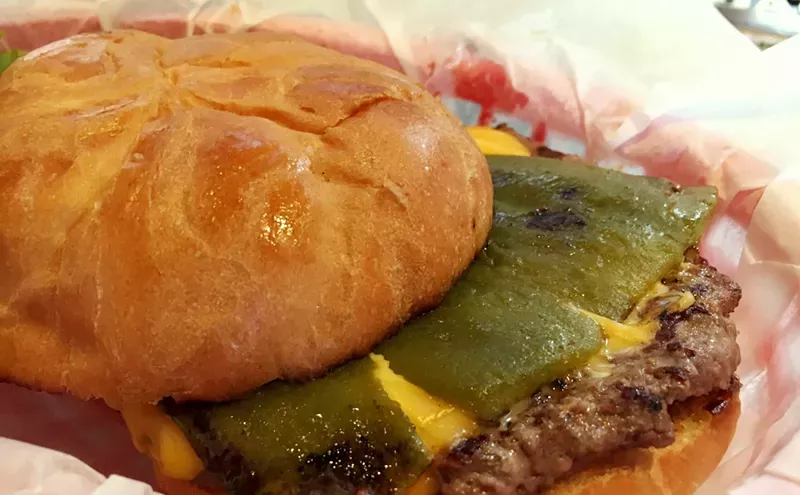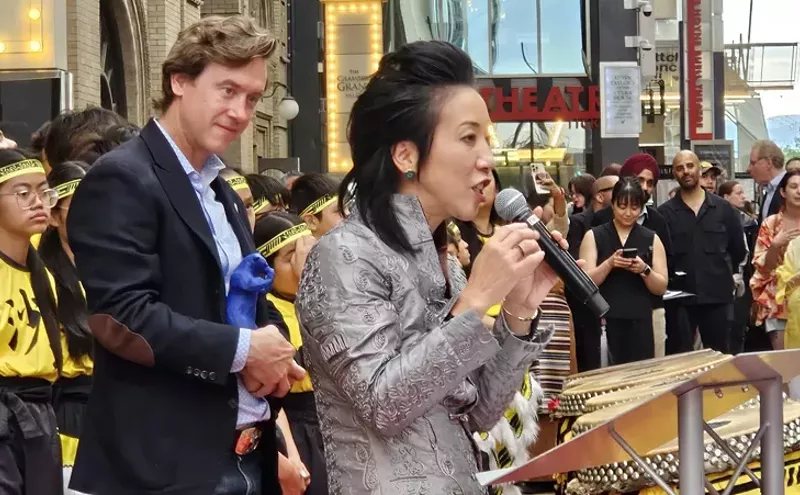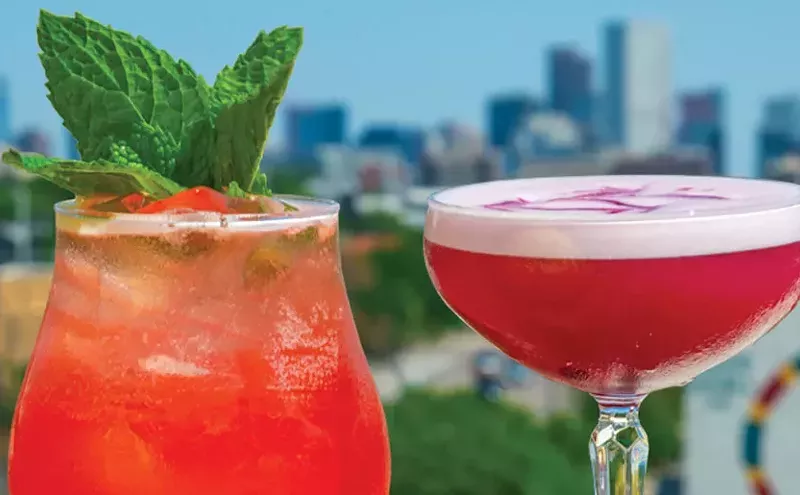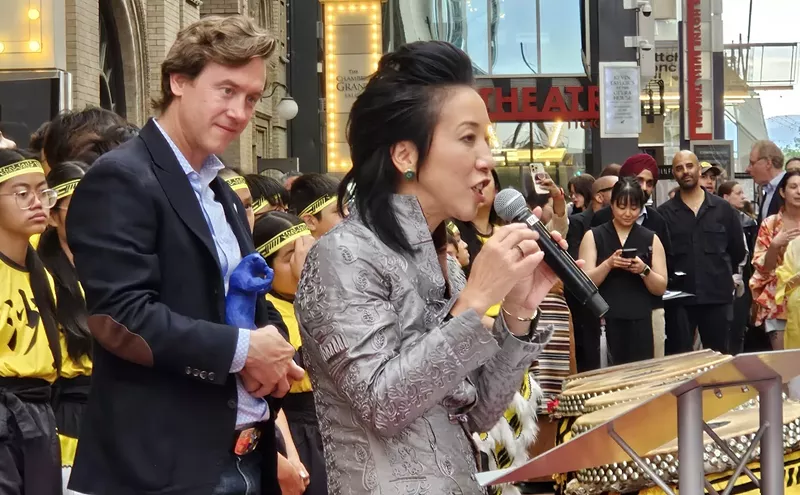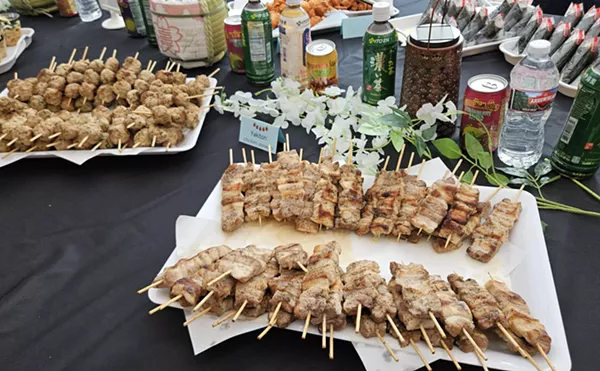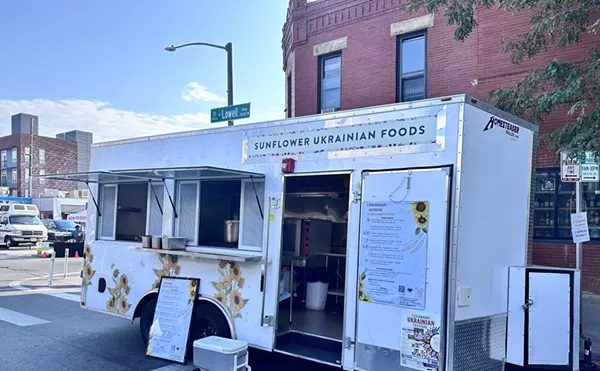Back at the dawn of American cuisine (I'm talking the '30s -- the goddamn Paleozoic Era, foodwise) there was the hamburger, and all things sprang forth from it. Sure, we had our Betty Crockers with their apple brown betties, ham with pineapple rings, and terrifying Jell-O molds. And we had regional cuisine -- Southwestern chili/chiles, Acadian gumbo, tidewater BBQ, scrapple, hash and cornbread -- deep veins of traditional cookery that, in subsequent years, would be plumbed, explored and then ruthlessly strip-mined. We even had some rotund fellows like the late James Beard, who acted as tireless, P.T. Barnum-style promoters of our gustatory cornucopia.
But in the beginning, there was the hamburger. And when we started exporting our culture around the globe, the hamburger went first. It was our vanguard, our tip of the spear. Like cavemen, we offered up meat and fire as if no one had ever thought of that before. And when the world mocked us -- taking the hamburger politely, but with a wry smile, and telling us what a clever little culture we were for thinking of such a thing -- we did what Americans always do when our elders, betters and France tell us that something of ours isn't good enough: We added cheese.
More than that, we added special sauce, lettuce, (more) cheese, pickles, onions and a sesame-seed bun. We learned how to make the hamburger bigger, better, faster and in wondrous variety. We developed an entire industry designed to ensure the hamburger's speedy delivery to the masses. We added teenage girls in short shorts and rollerskates to the mix, tied the hamburger to the muscle-bound American car culture, employed a generation of pimply-faced boys to dunk the fries and make the milkshakes that went with the hamburgers, then employed their fathers in the slaughterhouses and rendering plants that supplied the beef. We invented takeout. We invented drive-thru. We invented prefab. We grew burger franchises like mushrooms -- in big, funky clumps -- and developed an interstate highway system specifically to create off-ramps, because off-ramps are where franchises flourish.
And then, when that still wasn't enough, we started a few wars to make the world ostensibly safe for democracy, but mostly for cheeseburgers. World War II, Korea, Vietnam -- am I saying that these terrible conflicts were all fought so that Ray Kroc (the father of McDonald's and the secret king of Burgertown) would have new markets for selling his meat patties? Yes, I am. Sure, there were the Nazis, and they were some pretty bad guys. There was also the Red Menace, the Yellow Peril, the Mauve Hazard, international communism and all that, but mostly we fought for cheeseburgers. And say what you will about the catastrophic loss of life involved, the cities burned and the governments toppled, but goddamn if there isn't a Mickey D's right now in Red Square selling Quarter Pounders to the (former) commies. I could get on a plane right this minute and fly to Ho Chi Minh City for Burger King takeout, a bucket of KFC Extra Crispy and a chalupa. I could go to Paris for some McNuggets, Seoul for a milkshake and Toronto for a super-sized order of fries -- and we didn't even have to invade Canada.
Yet.
But the burger wars of the twentieth century were not fought exclusively on foreign soil. For decades, we had a civil conflict right here in the States, fought by a thousand rival burger franchises, and while it was essentially bloodless, it was no less fierce. Just about everyone has a long-gone chain remembered from childhood -- some place whose memory will be forever entwined with the feel of the back-seat upholstery in the family station wagon or that weird, achy sense of dislocation that came on the third day of a driving vacation when Dad finally limped the Family Truckster across the state line and you arrived somewhere totally, terribly different. Maybe it was a Burger Castle or a Burger Chef, a Lum's, a Lenny's or a Howdie Beefburger. For me, it was an A&W franchise somewhere in the deep South where you ordered through a little tin box on a pole and a roller-skating carhop brought your tray right out to you. Ours must've been ninety years old, wearing a paper hat and shorts in the orange-and-brown A&W corporate colors, and she was really too old to negotiate the curbs, so she just kind of stumbled over to the car with the tray in her hands, then stumbled back inside without speaking a word. We were the only car there. Maybe we'd been the only car in twenty years.
Late last Saturday I visited another casualty of the American burger wars: the sole surviving Denver outpost of the Griff's Burger Bar chain. Back in the day (and to be truthful, I don't know exactly when "the day" was, since this outfit's history is so spotty), Griff's could have given McDonald's a run for its money. The interstate chain owned by the Griffiths family was based in Texas, with locations stretching from Louisiana to Arizona and maybe as far north as Ohio. It had branding -- every Griff's outpost was done in the same steep-sided, A-frame style with the same bright-yellow sign out front that screamed HAMBURGERS in big, block capitals -- as well as drive-thrus. It had a mascot (some creepy little red-and-white-striped mutant-dwarf-clown thing named "Griffy," who exhorted you to stock up on nineteen-cent cheeseburgers), it had patio dining and, most important, it had location. No Griff's was more than spitting distance from a highway off-ramp, and many sprang up right alongside the beam of Route 66.
But Griff's was unable or unwilling to evolve, and that killed it -- or at least knocked the chain out of the big leagues and relegated it to a burger backwater, where it survives today only on nostalgia and the savage loyalty of its regulars. When McDonald's started experimenting with salads, Griff's stuck with burgers. When Burger King tried chicken sandwiches, Griff's stuck with burgers. When Taco Bells started popping up everywhere, Griff's kept making burgers. I can only imagine the senior Griffiths sitting in corporate headquarters somewhere in Texas, surrounded by posters of past advertising successes, chomping a cigar and croaking out dictums to his heirs. "This health-food thing is a fad, I tell you. Chicken sandwiches? Burritos? No way! No one is ever going to pay two dollars for a drive-thru salad! Burgers, fries and milkshakes built this company, and burgers, fries and milkshakes will see us through. Now, dance for me, Griffy! Dance like you did in the old days'
Pulling off Broadway into a parking lot dwarfed by the I-25 interchange, you see the sad remains of the car culture that kept places like Griff's alive. There's a primer-gray T-bird withering under the sulfur glow of the HAMBURGERS sign (the G is burned out), air intakes chopped into a hood the color of midnight and Bondo, a peeling Edelbrock sticker on the passenger window. A clapped-out, small-block motorcycle leans drunkenly by the door, as if the Fonz had rolled up here on a cross-country tour after Happy Days ended, gotten a job flipping burgers in the back and never left. Through the windows, you can see into the dining area -- the hard tables and curved plastic seats uncomfortable to any upright mammal, all empty and harshly lit by cold, businesslike flourescents. It's like the employees here are terrified of shadows, afraid to turn the lights down for fear they'll go dark altogether.
But going through the drive-thru brings back some of the old magic. Although the Griff's chain has made some feeble attempts at modernization -- in Albuquerque, the Griff's on Central serves green-chile burgers and Tater Tots stuffed with jalapeños and cheese; one location in Arizona offers a mesquite BBQ burger -- the board of fare sketched out on this menu is dominated by the classics. Griff's has always made good burgers: fresh, generous and assembled with care. A Giant single brings one small patty -- broiled, hot -- on a soft burger roll with onions, pickles and mustard. A Griff's Giant double (the chain's signature burger, mostly by default) is larger in radius and by gross volume, with two big patties, cheese, fresh lettuce, pickles, tomatoes and onion all wrapped in waxed paper that turns translucent with grease even before it's handed through the window.
Griff's makes salty french fries and battered onion rings, both kept down in the oil a little longer than usual so that they're always crisp, never pasty or flaccid. And Griff's serves milkshakes -- good milkshakes. Thick milkshakes, so thick the straw is a joke, way too rich to be any good for you, available only in the holy trinity of milkshake flavors: vanilla, chocolate and pink (strawberry, allegedly). There's no pumpkin, no mango-banana, no McCrappleBerry Swirl. A milkshake like this is the only culturally sanctioned beverage-slash-dessert that can be served with a proper burger and fries (like cold Coke in the can with pho, or beer with chicken wings). Those cupholders in your new Eddie Bauer-edition SUV weren't originally designed to hold glasses of chablis, you know. They were intended to hold milkshakes in sticky Styrofoam cups so that you could drive with one hand and heft that burger with the other. We fought wars over this, people. It's important that we remember our history.
On the other side of town in what I'd politely call a sketchy neighborhood is another sort of burger joint, one that comes with no history lesson, no Texas millionaires, no mascot. Hell, this one doesn't even come with a sign -- just its name, Caro's Corner, hand-painted in yellow right on the side of the hundred-year-old building on the corner of East 35th Avenue and Gilpin Street. Here, in a spartan, oddly shaped space squeezed in next to a bodega and a private garage, Jeffrey Patterson practices the burgerman's trade without a net.
Or chairs, for that matter. Decor consists of one bench (a church pew, if I'm not mistaken); a couple of unused counters; three or four Bibles; a whole lot of Polaroids of family, friends and football players; a rough clay crucifix hung above the pass window between the floor and the kitchen; a glass case -- empty but for Caro's license from the city and a poorly photocopied picture of the place back at the turn of the last century -- and a large dry-erase board listing the extent of Caro's offerings. There's the Caro's burger, with or without cheese. There's the double Caro's burger, with or without cheese. There's a regular hamburger, a regular cheeseburger, one size of fries and, on Fridays, catfish nuggets: nine for four bucks, a dozen for five.
Stepping through the iron-mesh door, I like this spot immediately for its purity: Patterson and his wife, Linda, cook burgers for the neighborhood -- and that's it. I like this spot because it's a truly independent enterprise, the absolute antithesis of the theme restaurants I loathe. After the original owners sold their place to Patterson's grandfather in the '60s, he kept the name Caro's Corner and kept right on cooking into the '80s. Then the place went dark and passed into the safekeeping of the Pattersons, who reopened it as Caro's Corner in the '90s, closed it again when they couldn't afford to have the roof fixed, put together a few dollars (okay, a lot of dollars) and fixed the roof, and finally re-reopened this past June.
I like Caro's Corner because it does not serve fast food. Patterson spends nearly twenty minutes assembling two Caro's burgers and an order of fries for me, and while I wait, I lean against the counter talking football (specifically, CU's trouncing of CSU in the season opener) and boxing with the only other customer in the joint. And he is waiting even longer for his food, because his only other plan for the day is watching the Broncos-Raiders game that night, so he has nowhere to be for the next, oh, five hours or so.
Above all, I like Caro's because its burgers are good. They're huge, big as pancakes. I watch Patterson form each patty by hand before slapping it on what must be the world's oldest flat-top grill. I watch him heating the cooking oil in a stock pot on an ancient, black, grease-caked four-top stove and then dunking the steak-cut fries in the basket of an old pasta strainer (too soon, it turns out, since my fries are pasty), while steam curls over the lip of the ventilation hood and straight up through a hole hacked rudely in the ceiling.
I eat two of these monster burgers -- the meat packed loose, and spicy with black pepper, onion salt and maybe a few secret ingredients I didn't ask about; mounded up with mayo, mustard, pickles, onion, lettuce and tomato that I know is fresh because I see Patterson mangle every veggie to order; and topped with melted slices of individually wrapped cheese product. Each burger arrives hot off the flat-top in greasy wax paper, and if the service doesn't exactly come with a smile (more of a scowl, really), the slow transaction of order to delivery ends with a solid "Thanks for coming," and that's enough for me.
Patterson makes one fine burger, the sort of burger you take one bite of while driving and set aside, only to start hoping for red lights so that you can go back for another bite. And another.
And that's what we're fighting for, after all. For Mom and Pop, apple pie and cheeseburgers. Good, old-fashioned cheeseburgers.



